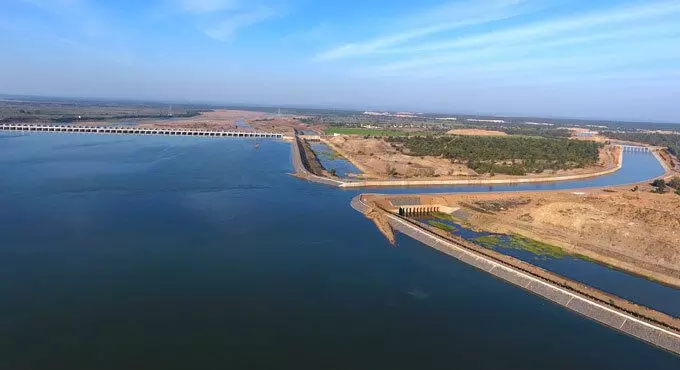Opinion: Fiction versus facts on Kaleshwaram Lift Irrigation Scheme
The pump houses at Annaram and Kannepalli, built as part of the mammoth Kaleswaram Project, were inundated by the floods to river Godavari.

HYDERABAD: The pump houses at Annaram and Kannepalli, built as part of the mammoth Kaleswaram Project, were inundated by the floods to river Godavari due to copious rains across Telangana on July 12, 13 and 14. Dispelling fears surrounding this, Penta Reddy, Advisor to the Telangana Government on Lift Irrigation, said that it was an obvious case of natural calamity wreaking havoc and there was no cause for worry.
In a press release, he said that this was not a first-of-its-kind incident and similar occurrences were witnessed in the past in the undivided Andhra Pradesh state besides several other parts of the country. In 2009, the underground hydel power generation plant in Srisailam and the pump house at Kalvakurthi were submerged due to floods received to river Krishna. Penta Reddy clarified that those ill-fated plants were restored to their full operational capacity in no time.
He made a passionate appeal that natural calamities should not be viewed from the prism of politics and that the whole society should be on the same page to bail out people from hardships.
And yet, the opposition parties are blaming the state government for this. The Telangana PCC president, in particular, was harsh in his criticism of Penta Reddy in utter disregard for the latter's age and vast experience in the field. Not just political voices, a few other groups have also joined this chorus, ignoring their social responsibility and making unwarranted comments on the submergence of the Kaleswaram pump houses. Their biggest claim is that the state government was using natural calamity as a convenient refrain to cover up the faults in the design and quality of the pump house.
Here is my detailed response to all their critical claims:
Fiction: The entire Kaleshwaram project was constructed without using basic engineering technology. One flood is what it took to expose its inferior quality. The latest flooding was way below the danger mark as stipulated by the Central Water Commission (CWC). Still, it left the two pump houses (Annaram and Medigadda) under a sheet of water. It resulted in a colossal loss running into several crores of rupees. The government could have averted this disaster had the Kaleshwaram project been built in complete compliance with the CWC's norms for draft design on water flow estimates and quality standards.
Fact: It is nothing but a hollow comment as this year's flood was unprecedented in nature. No one should forget the fact that it was a '500 years frequency flood', meaning a flood with an intensity that occurs only once in 500 years. When the Central Water Commission accorded the hydrology clearance for Kaleshwaram project on 30.10.2017, the quantum of the '500 years frequency flood' determined by it then was 81,576 cumecs or 28,80,829 cusecs. The Kaleshwaram Barrage was designed accordingly to withstand a flood of this capacity.
A total of 85 gates were set up specifically after giving due consideration to the possible afflux that results from a barrage construction.
The 'high flood level' (HFL) at Kaleshwaram, as determined by the CWC in 1986, was 107.85 metres. Based on this HFL, all the control levels of the barrage like FRL, gate hoisting level and bridge level were decided. Bunds were constructed and pump houses were also built.
As per the CWC standards, if the water level of river Godavari at Kaleshwaram is recorded at 103.5 metres, then it is considered as the warning level. If the river is flowing at a level of 104.75 metres, then it can be construed as 'water crossing the danger level'.
The floodwater level of river Godavari at Kaleshwaram was recorded at 108.19 metres on 14.07.2022, in excess of the HFL determined in 1986. The flood capacity recorded between July 13 and 14 was estimated to be over 28-29 lakh cusecs. It should be noted that these figures were arrived at by the CWC authorities and not the engineers of Telangana.
The Kannepalli pump house was submerged only because of this unprecedented flood.
Only the 'engineering experts' who came up with this document should be able to comprehend where was the scope for inferior standards and faulty design in this. It's not appropriate to see this from a political prism and speak like politicians do even when the natural calamity causing the submergence is clearly visible.
Fiction: Backwater effect increases river water level even during a low-intensity flood. Failure to take the backwater effect into consideration was the root cause for the submergence of the Kaleshwaram pump houses.
Secondly, the argument that floodwater received at Kaleshwaram was more than it was in the past is baseless. Reeling out comparative figures in cusecs is only meant to divert the public attention from the real failures.
Also, this is a matter of smart river water and reservoir management. Foolproof plans should have been put in place on aspects like the quantum of water to be stored in our reservoirs based on the inflows from upstream and how much water should be released in advance. Looks like, the government is trying to keep the people confused between cusecs and cubic feet.
Fact: It is not the government but these so-called engineering experts who are trying to confuse the public on the backwater effect. They have no idea how dams are different from barrages. At the time of designing dams and barrages, the backwater effect is invariably calculated to determine the number of gates and eventually minimize its impact.
At Medigadda, the number of gates required for the 81,576 cumecs of water capacity is 77. Still, the number was enhanced and 85 gates were designed, largely to avert the afflux impact.
While dams are constructed for storing purpose, barrages are meant to be diversion structures which are kept in 'free flow conditions' during floods. The scenarios expressed here are only applicable to dams and not barrages.
It's a weak argument to say that the backwater effect was not taken into consideration. Because, the Medigadda barrage was very much in free flow condition during the flooding time.
Only storage reservoirs face the backwater effect and not the barrages.
Fiction: The gates of Medigadda pump house were damaged under the flood water impact before it was submerged. This is an issue related to the quality standards and cannot be linked to the flood flow.
Fact: Any structure is prone to get damaged when it takes on pressure that is more than the limit estimated at the time of its design. The Kannepalli pump house was constructed 20 km away on the higher plane from Medigadda barrage. The inundation of both the pump houses is a result of unprecedented floodwater pressure and there is no fault in their designs.
In 2009, the Srisailam underground hydel power plant, the SLBC tunnel and even the entire Kurnool town were inundated due to floods to river Krishna. At 885 feet of FRL, the Srisailam dam discharge capacity then was 12 lakh cusecs and at 892 feet, it was 13 lakh cusecs. But even with the inflow of 7.25 lakh cusecs, the water level surpassed the maximum water level and touched 896 feet. Under these unprecedented circumstances, the Srisailam hydel plant was submerged. It is ridiculous if anyone sees this as a result of a faulty design.



